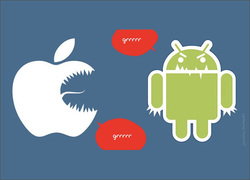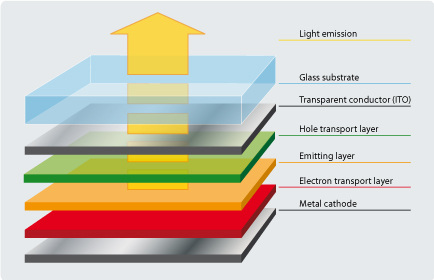 There has been a bitter clash between corporations when it comes to apps, not least because of the frankly petty issue of the physical name of the app shop itself[1]. This battle led to the name change from the Android App Store to Google Play. Apple first claimed the rights to the name `App Store` back in 2011, claiming that the company thought of the name themselves more than 5 years ago. Amazon dismissed this, stating that the term was generic and wasn't something to be fought for. After a long (expensive) struggle, Apple conceded that there was no need to pursue it, as “With more than 900,000 apps and 50 billion downloads, customers know where they can purchase their favorite apps.”
The two main competitors, Apple and Android are not as similar as most people think. Their main differences lie in their app guidelines. In order to publish a digital app on the IOS store, one must conform to a number of constricting rules and regulations[2] in order to ensure consistency and obedience within the store. Most of said rules are routine; and serve more for safety than control, however Android and other app publishers have more of a flexible look on things, and are seen to be much more easy going when it comes to what is published.
 Apple's case was not helped by the fact that their recent IOS 7 update allowed hackers to access the personal data of the public through a security glitch[3]. It is this and other issues that publishers must consider when releasing or even developing an app for use by said public.
Android is not without its shortcomings, for example in the adult app industry; where published dating apps were charging for a simply non-existent service. Perhaps Apple had the right idea after all with their strict guidelines.
Word count: 306
Augmented reality technology gets its name from the method by which it supplements real world inputs (such as visual scenes or audible sounds) with computer generated outputs (such as graphics or enhanced audio)[1].
As with almost all innovative technologies, augmented reality is of immense importance to publishers; primarily because it potentially marks the next trend in the technological market; and where there are trends, there is profit. Another key aspect of it is that it provides an easy interactive platform to market their products. This is crucial as publishers are able to create another dimension for their advertising. Imagine you are reading a magazine and you see an augmented reality app icon. You can use the open app with said magazine and suddenly are provided with an interactive experience full of information on the given subject.
To give an example, the Japanese car manufacturer Honda developed an augmented reality system[2] by which users could view a 3D exploded view of their cars just by using this amazing technology. Another great use of this technology, which should be of great interest to publishers is in education. Shown below is one of the many applications that can be used to instruct and inform students in a variety of areas. It's not all good of course. Depending on the type of image recognition software that you're using, it could use a high amount of data usage. Another disadvantage would be if your phone is not advanced enough for such technology. How do publishers reach them? What if you don't have internet access? These are questions that must be considered by all publishing companies.
The reason that this is such an important advancement in technology is because of its wide variety of uses in a wide variety of areas; for example in gaming, sports, medicine, military, TV and tourism. The main use that publishers should concern themselves with is in advertising as previously mentioned.
As with all upcoming (and of course established) technologies, augmented reality is something that publishing companies should get involved in if they wish to keep up in today's world. It is incredibly easy to fall behind nowadays and publishers that miss out on augmented reality and all its great uses could find their position in the market very compromised.
Word count: 379
Piracy is a concern for all, no matter what area of business they are in, and internet piracy affects the sales and profit figures of every company out there. This is particularly prevalent in publishing. Officially known as copyright infringement, the practice of piracy directly inhibits the progress of publishers, most notably those who are attempting to initially launch their products.
 When people discuss piracy, they often compare it to theft. However rather than the taking of physical objects from someone's possession, we generally refer to it as exercising one of the exclusive rights of the copyright holder[1]. That is, viewing, using and/or distributing something that belongs to an unaware legal owner.
As a brief reference regarding statistics, music as a sector saw the highest volumes of illegal content consumed over the period compared to TV (56 million), films (44 million), video games (35 million), computer software (27 million) and books (8 million)[2]
So what motivates people to pirate content? Well the main cause of (chiefly internet) piracy is an unwillingness to pay for a product when a free (albeit illegal) alternative exists. Secondly, and quite ironically, another reason for piracy's prevalence is because many people wish to avoid having to view the lengthy and `unskippable` anti-piracy adverts (or any adverts at all, in fact). Another reason could be the fact that people (again, primarily when on the internet) wish to remain anonymous. Most, if not all, pay-for-service sites require a username and email address as identification before a product can be bought, and many see this as an unnecessary inconvenience when piracy sites require nothing of the sort. A fourth motive for piracy is lack of availability. It is this cause that I will focus on now.
When a product or service is unavailable in someone's country of residence, whether for copyright laws or other reasons, it can be immensely frustrating, and it is only natural that one would look to piracy if it were to solve one's problem. However it is my opinion that it is not so much lack of availability that is key to the growth of piracy, rather lack of accessibility (no they are not the same).
 So what can publishers do to combat this issue? Well it has been countered in the past, most notably in the video game industry. This is a clear example of where piracy was actively shown to decline[3]; and this was chiefly due to an increase in the accessibility of paid for products. A digital distribution company known as Steam led the change by creating a hugely rewarding community that is not accessible by pirates. Achievements, free-to-play games, DLC (Downloadable Content) and an online, unrestricted and open world to share with all other Steam users is something that even pirates couldn't resist. Steam developers made their content so easily accessible and open that people were actively choosing to pay money for the service that was provided rather than pirate the content. The developers of Steam, known as Valve Corporation knew what the people wanted and provided it. It directly reduced piracy figures and was mainly due to the company being, as CEO of Valve Gabe Newell puts it, "customer centric rather than production centric". In an interview with TCS[4], he said, "Most of our decisions are based on the rapidly evolving opportunities to better serve our customers, and not on optimizing to be a better game company or digital distributor. The latter focus would be more of a straitjacket than conceptual aid." It is this approach that made the company as successful as they are today.
So as the above paragraph demonstrates, piracy can be combatted, and it is this attitude that publishers must concern themselves with; how do they make their products more accessible? How can their services be more readily available? These are the issues that publishing companies need to address and until they do so, they could risk falling behind, and being overwhelmed by piracy.
Word count: 659
 QR codes are essentially a relatively new style of 2D barcode that a machine can interpret and convert into readable data.
First released in 1994 and winner of the 2012 Media for Industry category of the `Good Design Award`[1] , Quick Response Codes made their mark in business (and the publishing industry was no exception), over a very short amount of time.
The phrase "necessity is the mother of invention" is no less true when it comes to QR codes. Before they came about, traditional barcodes were found to be very lacking when it came to storage space. This is because they only had the capacity to store 20 or so alphabetical characters of information which, whilst they made the lives of numerous cashiers significantly easier, was simply not enough a lot of the time.
And so along came Masahiro Hana who - unlike many other 2D code developers who were trying to cram as much space as possible into their codes - realised that it was more about general speed efficiency. The distinctive pattern is no random accident; the squares in each corner are specifically designed to maximise the response time of whatever device is trying to interpret the code. Known as a "position detecting pattern", the design was created by doing an exhaustive survey into business documentation, looking for common patterns and researching which colours and shapes do not appear very often. Using this information Masahiro was able to create the optimal code for fast and easy recognition by enabled devices. And thus, the Quick Response code was invented.
In addition to this speed efficiency and high storage space, QR codes also have the advantage of dealing with damage/loss of data very well. Using its error correction capability, the codes are able to restore up to 30% of lost data depending on what level the user chooses, at the expense of code size[2].
 Storing information both horizontally and vertically (hence the 2D nature of the code) means that QR codes are able to take up approximately one tenth of the space of traditional barcodes[3]. That's not even taking into account micro codes, which only need one of the position detection patterns[4]. They cannot store quite as much information as regular QR codes, but do code said information more efficiently.
QR codes are a way of making things more convenient, and this is the primary reason as to why their popularity has grown so exponentially. They have uses in manufacturing, retail, warehouses, medicine and many other services. Publishing is no exception here. Publishers want to stand out and engage users as much as possible, and QR codes are a way of establishing a bridge between offline and online media[5]. QR codes can transform a printed page into a 3D interactive screen with the right program and their uses seem limitless.
 These codes have a number of benefits in digital publishing, increasing revenue, engagement, online presence and more efficient management.
They have great uses in advertising as well, allowing the audience to learn more information about a product without said information filling the advertisement for example.
One potential disadvantage of QR codes is that one needs to have the correct reader software on them in order to actually interpret the code,[6] which is currently only available on smartphones. However this technology is pretty much standard on any device being brought out these days, due to the strong presence that QR codes have in today's world.
In conclusion then, QR codes are an extremely efficient form of data storage and transformation and have with good reason become standardised in all areas of business.
Word count: 602
Gesture recognition is no longer unique to the sci-fi movie genre. Whether it was Tom Cruise manipulating glimpses into the future on a giant transparent screen or Robert Downey Jr taking apart his virtual Iron Man suit in his basement lab, most of us used to think that it was all restricted to the fantasy world. However recent advances in gestural interfaces have led us to realise that we too might soon be able to harness this amazing technology for ourselves.
Simply taking a brief look at the video below demonstrates just one of many upcoming products taking this technology to market. This is the Leap Motion which essentially supports hand motions as an input, as a replacement to a traditional mouse[1]. Leap Motion Inc. is in partnership with ASUS and together they are one of the many groups looking to bring us this new technology.
Gestural Interfaces encourage HMI (Human-Machine Interaction) and could potentially make current input devices (such as computer mice, keyboards and even touchscreens) redundant in the future.
Unfortunately it's not as simple as a camera seeing you move your hand and knowing that you want to turn a page in an e-book or turn up the volume of your TV programme. This technology uses mathematical algorithms[2] to interpret human gestures and then transform them into visual functions on a display. Essentially the sensor detects changes in the physical environment and transforms them into computer inputs for digital processing inside the machine. From there it can display the resultant action.
There is of course the obvious disadvantage of lack of compatibility with disabled people (for example people with loss of limbs/digits), however improvements are being made to combat this such as with accelerometer based gesture controlled systems[3].
So how does this relate to publishing? Well such a prominent future technology requires attention from all branches of a company, none more so than the people who are actually going to publish the applications or products. When it comes to the hype cycle of emerging technologies, gesture recognition is past the trough of disillusionment and well on its way through the slope of enlightenment to the plateau of productivity[4].
In conclusion then, gestural interfaces signal the next trend in computer and display technology, and after further development could be seen to be standard in the average home.
Word count: 388
References
Minority Report image: http://www.artefactgroup.com/content/wp-content/uploads/2011/02/Tom-Cruise-minority-Report.jpg
Iron Man image: https://lh4.googleusercontent.com/-5WWpeHSjIPw/UajTluk7-4I/AAAAAAAApUg/dTETe_uyCYs/w506-h285-o/iron-man-gestures.jpg
[1] https://www.leapmotion.com/company - Accessed 12/10/2013
[2] http://mm-werkstatt.informatik.uni-augsburg.de/files/publications/199/wave_like_an_egyptian_final.pdf - Accessed 12/10/2013
[3] Moniruzzaman Bhuiyan (Sept 2011) - www.scirp.org/journal/PaperDownload.aspx?paperID=7503 (PDF) - Accessed 13/10/2013
[4] Gartner (July 2012) - Accessed 13/10/2013
This week I have been looking at Organic Light Emitting Diodes. They are essentially a way of displaying something on a screen, whilst being able to be manipulated by the outside environment, for example being bent and twisted, wrapped around something or even folded up and put in one's pocket. Because of this feature, the technology has caught the eye of some big names in publishing. Just imagine being able to wrap your phone around your wrist, or having an interactive tablet that you don't have to worry about dropping all the time.
So what exactly is an OLED? These diodes glow when an electrical current is applied to them[1], and are made primarily for TV and mobile devices. It is a next generation technology which will soon take over the current LED market. Due to this upcoming prominence, publishing companies are starting to look more closely at this technology and are beginning to apply it to their future models.
Samsung in particular, with their sub-company Samsung Publishing Ltd, who own the majority of the market share when it comes to smartphones have been declared the leader in OLED display research and the clear leader in AMOLED (Active Matrix OLED) production, holding a 98% share of this market[2]. Their displays are thinner and of better quality than that of LCD or plasma screens. Samsung distribute OLED screens to most mobile phone companies, and produce 40% of OLED displays.
First observations of this organic technology were actually made way back in the 1950s, and it has progressed from there.
OLEDs operate by using a variety of layers, outlined in the image below. There are many advantages to OLED; a key aspect is that it will have lower costs in the future as it can be printed on any suitable substrate. This theoretically leads to cheaper production costs than current screen technologies available[3].
OLED displays allow the possibility to be fabricated on flexible plastic substrates, allowing for amazing new concepts such as roll up displays, displays which can bend and be manipulated without damage. Displays can also be embedded into clothing and fabrics for example. These are just a few of the reasons why publishing companies are taking a keen interest in OLED technology, as it opens a lot of doors for the future.
There is a flipside to the coin however. The steps needed to produce OLED displays are extremely expensive currently. The processes involved are time consuming compared to (for example) LCD alternatives.
Because of its organic nature, the lifespan of one of these displays is lower than current technologies. There are other disadvantages regarding things such as possible water damage etc, however truthfully publishers need not concern themselves with these, since it is more the responsibility of other aspects of the company.
One major thing that publishing companies should concern themselves with however is the fact that whilst OLED displays generally consume less power than traditional LCDs, when it comes to displaying white, for example a word document, the efficiency is blown out of proportion as OLEDs consume up to three times as much power. This is particularly a problem since the ebook market is so huge at this time, and word documents and books are very much prevalent in this industry.
In conclusion then, OLEDs are definitely the next big thing, particularly when it comes to smartphone technology, and we can certainly expect to see it become standardized in the near future.
Word count: 574
References
[1] What Are OLEDs? (No author) - http://dkc1.digikey.com/us/en/tod/Newhaven/OLED-Displays/OLED-Displays.html - Accessed 07/10/2013
[2] Samsung Market Share (No author) - http://www.oled-info.com/samsung-oled - Accessed 07/10/2013
OLED image: http://www.novaled.com/uploads/pics/g_Novaled_OLED_Structure.jpg - Accessed 07/10/2013
[3] Craig Freudenrich - http://electronics.howstuffworks.com/oled5.htm - Accessed 07/10/2013
|














 RSS Feed
RSS Feed